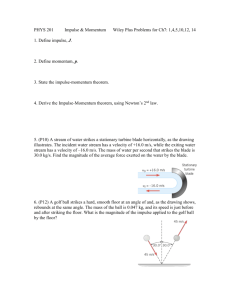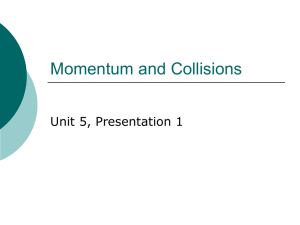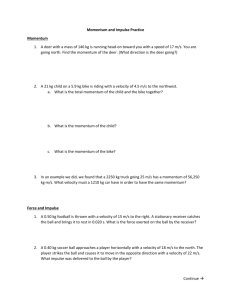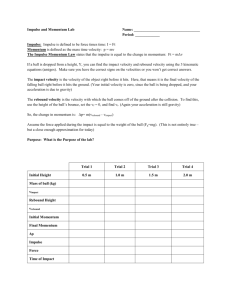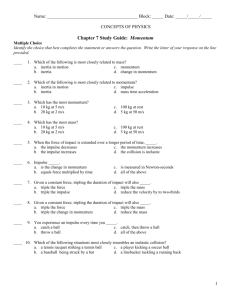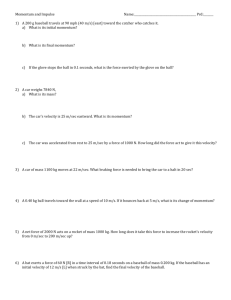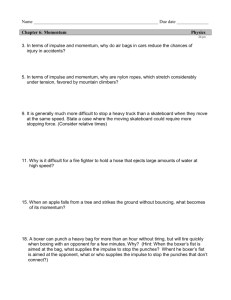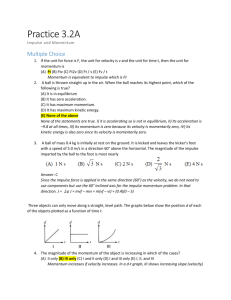Impulse - Education Scotland
advertisement
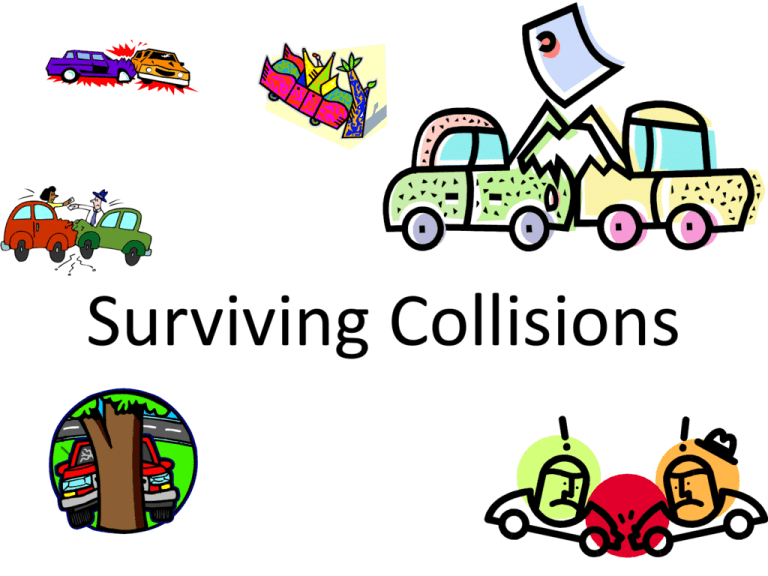
Surviving Collisions Car manufacturers spend enormous amounts of money and time to ensure that, in the event of a collision, the occupants of the car have the best chance possible of survival. Why? The European New Car Assessment Programme (NCAP) tests new cars and gives a safety rating for adult occupants, children and pedestrians. Results are published online. NCAP also publishes information on the protection for occupants offered by each new vehicle in the event of a rear impact collision, which commonly results in whiplash injuries. Explain whiplash injuries in terms of Newton’s laws. Car design engineers require a good understanding of the physics of collisions to be able to design cars that offer maximum protection to occupants and pedestrians in the event of collision. Which features of car design protect occupants and pedestrians in the event of a collision? Your research project is to design a crumple zone for our remotecontrolled car and provide evidence that your crumple zone design is the most effective protection in the event of a headon collision. You will research the physics of car safety, plan and carry out appropriate investigative work and prepare a scientific communication presenting the aim, results and conclusion of your work. Through this research project you will develop skills in: researching investigating analysing evaluating communicating Failure could have serious consequences… Don’t Mess with Impulse Why are crash barriers constructed on the central reservation of motorways and some dual carriageways? Why are cars designed with crumple zones? How are crumple zones designed? What materials are used for effective crumple zones? How can a comparison of the effectiveness of different crumple zone materials be made? The research Within your group you will each research individually the four key questions. As you review information, make notes and ensure you record full references. To be successful in this work you must demonstrate that you can evaluate materials on the internet for reliability and can summarise and explain information in your own words. Acting on impulse? When you jump, what’s the least painful way to land? Explain, using your research. If you fall off something, what sort of surface would you prefer to land on? Explain! The greater the force and the longer the time for which it acts, the greater its effect. So the relationship F × important one. t is an Impulse = F × t Impulse = Ft What are the units of impulse? Impulse and momentum In the clip, the mass of the ball is m. During the collision, the average force exerted is F or F . Impulse and momentum The velocity of the ball before the collision is u (in this case u = 0 m s–1) Immediately after the collision, the velocity is v. The force applied to the ball causes an acceleration a. Impulse and momentum F ma v u a t Impulse and momentum so v u F m t Mulitply each side by t Ft m(v – u ) Ft mv – mu Impulse and momentum mv – mu = change in momentum (measured in kg m s–1) impulse Ft = mv – mu = Δmv Impulse and momentum impulse Ft = mv – mu = Δmv Impulse = change in momentum caused by a force Impulse and golf practical diameter of ball = mass of ball = time to pass through light gate = time of contact = initial speed of ball = final speed of ball = Impulse and golf practical Calculate the average force exerted on the golf ball: Ft = mv – mu Impulse and golf practical How could the force on the ball be increased? Or decreased? What does this have to do with our crumple zone investigation? Look at each of the velocity–time and acceleration–time graphs. Describe the motion and decide which graphs match the collision without the crumple zone and which match the collision with the crumple zone. What information are you looking for to help you decide? What does a greater acceleration indicate about the unbalanced force? Without the crumple zone, the time taken for the vehicle to stop is 0.01 s. The maximum acceleration is – 65.63 m s–2. With crumple zone, the time taken to come to a stop is just under 0.03 s. That is three times the time taken for it to stop without the crumple zone. The maximum acceleration is – 42.77 m s–2. Investigate and compare the effectiveness of different crumple zone materials. With crumple zone, the time taken to come to a stop is just under 0.07 s. Explain why the acceleration is much less than in the collision without the crash barrier. Impulse and momentum impulse Ft = mv – mu = Δmv impulse = change in momentum caused by a force What happens when the ball hits the racquet? To the racquet strings? To the ball? The force–time graph for a tennis racquet hitting a ball might look like this: F (N) 0 t (s) What information can be obtained from the graph? F (N) 0 t (s) Investigating force–time graphs Start data-logging. Slightly push it from rest so it moves down the runway and collides on the force sensor. Fix a small spring on the force sensor. © PASCO Use the velocity–time graph to determine the velocity of the trolley before and after the collision. Calculate the change in momentum of the trolley. Use the force–time graph to determine the area under the graph. Compare the area under the graph with the calculated change in momentum of the trolley. Velocity v changes when the trolley collides on the force sensor Force (N) Time (s) max. F F F very short time interval 1.60 s 1.65 s Why does the force vary during impact? When a tennis ball is being hit by a racket, the ball is deformed. The force of impact increases to maximum when the ball is deformed most. As the ball regains its shape, the force decreases. For the same change in momentum, what happens to the average force as the time of impact decreases? F (N) The change in momentum remains the same. 0 t (s) What does this mean for the area under the graph? F (N) On the axes, sketch the graph for a shorter time of impact. 0 t (s) What happens to the average force? Which ball would you prefer to be dropped on your foot and why? Use the words force, time, change in momentum and impulse in your explanation! A trolley hits and rebounds from a force sensor and the F–t graph is obtained. Force (N) The area under graph is 0.46 N s. 8 7 6 5 4 3 2 1 1.75 1.80 1.85 1.90 Time (s) 1.95 2.00 What is the maximum force acting on the sensor during Force (N) impact? Area under the graph = 0.46 N s 8 7 6 5 4 3 2 1 1.75 1.80 1.85 1.90 Time (s) 1.95 2.00 Force (N) Maximum force = 7.8 N 8 7 6 5 4 3 2 1 Area under the graph = 0.46 N s 7.8 N 1.75 1.80 1.85 1.90 Time (s) 1.95 2.00 Force (N) Determine the change in momentum of the trolley. Area under the graph = 0.46 N s 8 7 6 5 4 3 2 1 1.75 1.80 1.85 1.90 Time (s) Area under the graph = 0.46 N s 1.95 Obtained by 2.00 data-logging program Force (N) Determine the change in momentum of the trolley. Area under the graph = 0.46 N s 8 7 6 5 4 3 2 1 1.75 1.80 1.85 1.90 Time (s) 1.95 obtained by 2.00 data-logging program Area under the graph = 0.46 N s Change in momentum = 0.46 kg m s–1 Force (N) Calculate the average force acting during impact. 8 7 6 5 4 3 2 1 Time of impact = 2.05 – 1.75 = 0.3 s 1.75 1.80 1.85 1.90 Time (s) Average in momentum = force time 1.95 0.46 = 0.3 2.00 = 1.53 N 324 m A careless school pupil drops a 1p coin from his pocket at the top of the Eiffel Tower. 324 m Calculate the velocity of the coin on impact on the ground. 324 m Calculate the change in momentum of the coin, making an estimate of the coin’s mass and the rebound velocity. 324 m Calculate the average force exerted by the coin on impact, estimating the time of impact. In this section you should have developed… • an understanding of the concept of impulse as a change in momentum, as it applies in sports and vehicle safety • skills in researching information on the internet, evaluating its quality and referencing appropriately • independent investigative skills • a greater understanding of graphs, interpreting to understand and describe motion.
